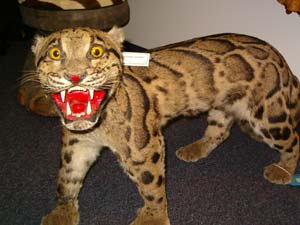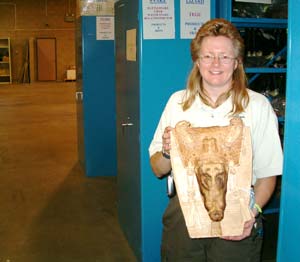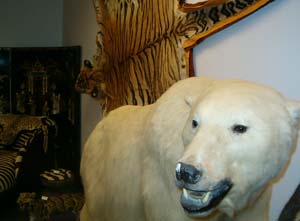Seized Menagerie
Air Date: Week of August 5, 2005

The U.S. Fish and Wildlife Service's Doni Sprague with one of hundreds of crocodile handbags in the warehouse of the agency's National Wildlife Products Repository in Denver. (Photo: Eric Whitney)
Reporter Eric Whitney takes us to The National Wildlife Products Repository outside Denver, Colorado. Here, more than a million illegal wildlife items—including stuffed tigers, snake boots, and dried seahorses—are catalogued, stored, and donated to schools, museums, zoos, and research facilities.
Transcript
YOUNG: Much of the demand for those animal products comes from the world's wealthy nations. Government agents in the U.S. have an uphill battle trying to intercept those smuggled goods at airports and boat docks every day. Ever wonder what happens to the stuff they do catch? We did. And we sent reporter Eric Whitney, of member station KRCC in Colorado Springs, to a Denver warehouse to find out.

This stuffed clouded leopard is one of scores of spotted cats held by the U. S. Fish and Wildlife Service's National Wildlife Products Repository in Denver. (Photo: Eric Whitney)
[SOUND OF ELECTRTIC MOTOR]
WHITNEY: Doni Sprage, of the U.S. Fish and Wildlife Service opens a huge, motorized cabinet. Inside is a collection of fur coats to rival anything in a New York boutique.
SPRAGUE: This particular coat here is mink, and you can kind of tell that when you look at the coat, it just has this incredible sheen that is hard to mistake.
WHITNEY: A price tag hanging on the coat says $3,995, but Sprague isn’t going to sell it, or any of the dozens of other jackets hanging here made of leopard, jaguar or lynx and other animal skins. Whoever tried to sell them in the first place got busted for dealing in illegal animal products, and their loot was sent here, to the National Wildlife Products Repository in Denver.
SPRAGUE: We have a wide range of items, including shell and coral products, reptile products, a lot of worked ivory, trophy animals, traditional medicines. You know, wildlife trade is a global issue, so we're seeing these items from all over the world.
WHITNEY: A “wide range of items” doesn’t even begin to describe what’s inside the gray walls of this 13,000 square foot warehouse. Shelf after shelf is stacked to the ceiling with animals and animal parts, from the exotic to the relatively mundane. There are huge cardboard boxes labeled “butterflies,” one shelving unit holds about 300 sea turtles - either whole stuffed animals or enormous shells. The heads of rare big cats stare mutely from inside plastic bags, their sharp teeth bared, their hides rolled up behind them.
A recent seizure brought in about 26,000 sea horses.
SPRAGUE: These all were destined for the medicinal trade. They've been dried and just would be sold in various markets as a raw ingredient to some type of medicinal.
|
WHITNEY: Sprague says that the Repository has more than a million seized items. Most come from the 16 designated ports of entry where wildlife products are allowed to enter and leave the U.S. Some items, like the huge rhinoceros head mounted as a trophy, are seized because trading in endangered species is illegal. Other products, made from common or domesticated animals, are confiscated for paperwork violations. [SOUND OF OPENING BOX, RUSTLING CELLOPHANE] SPRAGUE: These were seized at our border between the United States and Mexico at El Paso, and there are some endangered species violations, as we do see sea turtle and crocodile species, but many of these are ostrich, which basically requires only a declaration at the time of import or export. WHITNEY: Sprague, says she once heard that cowboy boots make up the majority of all seizures, and it’s not hard to believe. There is shelf upon shelf of pointy-toed shoes made from the skin of just about every creature that’s ever walked, slithered or swam on the planet. The fancy ones leave the snake heads mounted right over the toe. [SOUND OF BIRDS CHIRPING AT THE DENVER ZOO] WHITNEY: Here at the Denver Zoo, vice president for education Jackie Taylor opens one of the suitcases that she helps distribute to teachers. TAYLOR: Let's see, we have all kinds of different items in here to share with the kids [SOUND OF PLASTIC BAGS CRINKLING] TAYLOR: We have golden pheasant bird feathers, we have an ivory bracelet, we have a cowboy boot made from sea turtle skin, a tarantula paperweight.  The U.S. Fish and Wildlife Service's Doni Sprague with one of hundreds of crocodile handbags in the warehouse of the agency's National Wildlife Products Repository in Denver. (Photo: Eric Whitney) |
WHITNEY: Every year Taylor trains about two dozen teachers how to use the suitcases, which come with a teaching handbook and fully scripted slide show. The goal, she says, is to provide good information and let students decide how they feel about the global wildlife trade. The kids are encouraged to touch and feel the samples, which Taylor says really has an impact. TAYLOR: Yes, it does, because they continue to talk about it. Here's a crocodile handbag, you know, why would you do this? And what's different from this handbag to a handbag that is made from a synthetic fabric? WHITNEY: The Denver Zoo is just one of several zoos, schools and museums across the country that accept products from the repository. Other items are used for research, or by law enforcement in sting operations. It’s hoped that the education is having an impact on demand for illegal wildlife products, but every year the Repository continues to see an increase in the number of items sent to it. For Living On Earth, I’m Eric Whitney in Denver. Living on Earth wants to hear from you!Living on Earth Newsletter [Click here]
Donate to Living on Earth! NewsletterLiving on Earth offers a weekly delivery of the show's rundown to your mailbox. Sign up for our newsletter today!
|






